


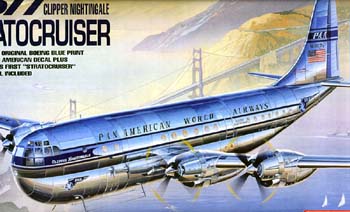 Academy
1/72 Boeing 377 Stratocruiser
Academy
1/72 Boeing 377 Stratocruiser
By Michael Benolkin
The Boeing Company has never been one to waste good engineering. With the sturdiness and load carrying capability that the B-17 had demonstrated, Boeing installed a new pressurized passenger fuselage on the familiar B-17 wings and tail, creating the Boeing 307. It became one of the first pressurized passenger aircraft in service.
Following the same thinking, Boeing thought about building a cargo aircraft and passenger aircraft line based upon the sturdy B-29 design. As the work progressed, however, the B-29 received a major set of improvements, especially in the powerplant arena, and the B-50 entered service. The cargo and passenger derivatives came from the B-50 series.
 So
came the Boeing Model 377 Stratocruiser, the pressurized fuselage retaining
the familiar lines of its older brother, the Model 307. First flown in
1947, Pan American World Airways pressed the Model 377 into service in
1949. Because of the spacious interiors of the Model 377, Pan Am was able
to continue its tradition of luxurious Clipper accommodations, with 52-60
first class seats on the main deck, and a lounge and bar on the lower
deck. Due to mechanical problems that plagued the Model 377, only 56 were
built and these were replaced with more reliable aircraft.
So
came the Boeing Model 377 Stratocruiser, the pressurized fuselage retaining
the familiar lines of its older brother, the Model 307. First flown in
1947, Pan American World Airways pressed the Model 377 into service in
1949. Because of the spacious interiors of the Model 377, Pan Am was able
to continue its tradition of luxurious Clipper accommodations, with 52-60
first class seats on the main deck, and a lounge and bar on the lower
deck. Due to mechanical problems that plagued the Model 377, only 56 were
built and these were replaced with more reliable aircraft.
One of the more unique epilogues to the Model 377 story is this - a number of them were acquired by Jack Conroy in the 1960s and converted into specialized airlifters to support the US space program. The early entries into the line-up were the Mini Guppy and Pregnant Guppy. These retained the same engines of the Model 377, but were modified with larger diameter fuselages and opening noses or tails to allow rocket boosters and other space hardware to be ferried from various parts of the US down to Cape Canaveral.
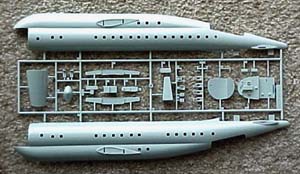 As
the race for the moon progressed, an aircraft capable of lofting larger
components (for the Apollo program) was needed, and Conroy delivered.
The Super Guppy, with the largest yet fuselage, a modified vertical stabilizer
were mated to the USAF-standard C-130 powerplant – the T56 turboprop
turning the three-bladed Curtiss Electric propellor. As the USAF replaced
the troublesome three-bladed prop for the now familiar four-paddle-bladed
propeller, Conroy likewise adopted this configuration to later Super Guppies.
At least one of the early Super Guppies never received the new propeller-
the example flown (until recently) by NASA. This example is now in storage
at Davis-Monthan AFB in Tucson AZ.
As
the race for the moon progressed, an aircraft capable of lofting larger
components (for the Apollo program) was needed, and Conroy delivered.
The Super Guppy, with the largest yet fuselage, a modified vertical stabilizer
were mated to the USAF-standard C-130 powerplant – the T56 turboprop
turning the three-bladed Curtiss Electric propellor. As the USAF replaced
the troublesome three-bladed prop for the now familiar four-paddle-bladed
propeller, Conroy likewise adopted this configuration to later Super Guppies.
At least one of the early Super Guppies never received the new propeller-
the example flown (until recently) by NASA. This example is now in storage
at Davis-Monthan AFB in Tucson AZ.
Even after the space race died down, the demand for the Boeing 377 did not diminish. Airbus Industries in France procured a number of Super Guppies to allow components of their Airbus line to be assembled around France (and Europe) and airlifted into the main plant for final integration. These Super Guppies are only now being phased out in favor of the 'Beluga' – a Super Guppy based upon an Airbus airframe.
One final note. The diameter of the Super Guppy modified fuselage is so large, that you can slide a C-5 Galaxy fuselage inside! It was fun watching the various Guppies being modified and flown on the ramp next door to where I learned to fly. One day a 'new' Boeing 377 would arrive, and over the course of weeks, out would emerge a Guppy variant.
The Kit
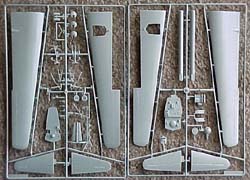 Academy
has really outdone themselves this time. This kit is huge! Looking over
the parts trees, you'll find no less than 25 parts that you won't use
in this project. Why? Because they've designed this model to give us an
early C-97 cargo aircraft and a KC-97 tanker in the near future! The characteristic
C-97 radome and the KC-97 wing and boom pods are here.
Academy
has really outdone themselves this time. This kit is huge! Looking over
the parts trees, you'll find no less than 25 parts that you won't use
in this project. Why? Because they've designed this model to give us an
early C-97 cargo aircraft and a KC-97 tanker in the near future! The characteristic
C-97 radome and the KC-97 wing and boom pods are here.
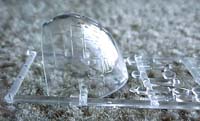 Despite
its size, the fit of the kit is very nice. One on the nice touches of
this design is the all-glass dome that makes up the nose of the aircraft.
Academy designed it so you can blend the dome into the fuselage without
endangering the clarity of the cockpit glass. And for good reason; the
flight deck is nicely detailed! The kit provides crew positions for pilot,
copilot, flight engineer, navigator and a spare seat.
Despite
its size, the fit of the kit is very nice. One on the nice touches of
this design is the all-glass dome that makes up the nose of the aircraft.
Academy designed it so you can blend the dome into the fuselage without
endangering the clarity of the cockpit glass. And for good reason; the
flight deck is nicely detailed! The kit provides crew positions for pilot,
copilot, flight engineer, navigator and a spare seat.
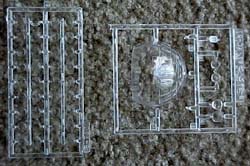 On
the downside, while there are good-sized portholes throughout the fuselage,
there is no interior provided. Also, judging from the relative center
of gravity, you'd better consider using some serious ballast in the nose
in order to keep the 377 from becoming a dedicated tail-sitter. This shouldn't
be a problem as there is AMPLE room inside the nose for ballast.
On
the downside, while there are good-sized portholes throughout the fuselage,
there is no interior provided. Also, judging from the relative center
of gravity, you'd better consider using some serious ballast in the nose
in order to keep the 377 from becoming a dedicated tail-sitter. This shouldn't
be a problem as there is AMPLE room inside the nose for ballast.
As with other recent generation large kits, Academy has provided wing spars to help hold this kit together. Given the sheer size and weight of the aircraft, you'll probably want to use something like Testors Liquid Cement to get the best bond/greatest strength out of the major fuselage/wing assemblies.
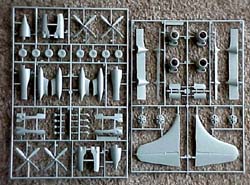 The
kit provides the wing flaps as separate parts, though they are intended
to be installed in the up position. Nonetheless, this will make it a little
easier for the detailer to pose the aircraft in takeoff or landing configuration.
The
kit provides the wing flaps as separate parts, though they are intended
to be installed in the up position. Nonetheless, this will make it a little
easier for the detailer to pose the aircraft in takeoff or landing configuration.
Academy provides a nicely complete decal sheet for two aircraft and all of the characteristic stenciling found on commercial aircraft. The two aircraft are NX90700; Boeing's Model 377 demonstration/test aircraft, and N1022V, Pan Am's 'Clipper Nightengale.'
This kit fills a major void in aviation history and will look great parked next to your KMC 1/72 727-200! I recommend this kit to any builder. My sincere thanks to MRC for this review sample!

Previous: Contents









